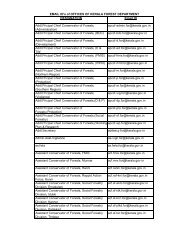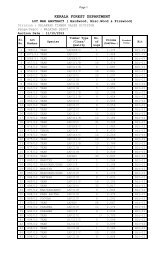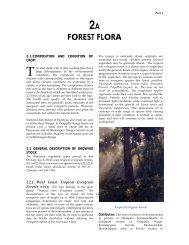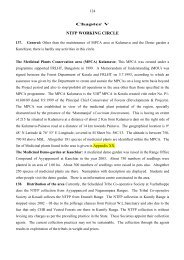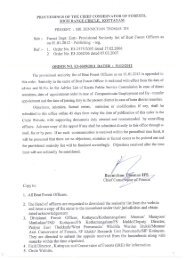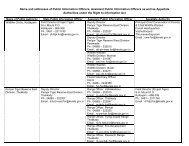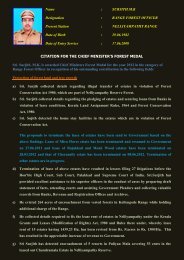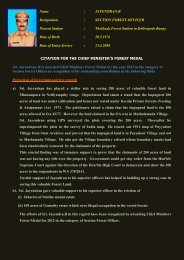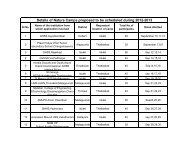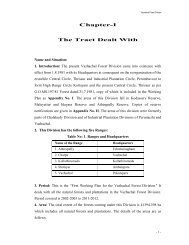Create successful ePaper yourself
Turn your PDF publications into a flip-book with our unique Google optimized e-Paper software.
in the category are considered as a mixture of both evergreen <strong>and</strong> deciduous<br />
type of tree growth. This forms a closed forest. Such type is met with around<br />
Mambazhathara <strong>and</strong> Kottakkayam in Achenkovil Reserve <strong>and</strong> in folds of hills<br />
<strong>and</strong> higher portions in Yeroor Reserve. The natural regeneration is<br />
comparatively less, because of more biotic interference. This type of forest is<br />
approximately 400 ha the floristic composition is as below. Top Canopy:<br />
Artocarpus hirsutus, Hopea parviflora, Terminalia paniculata, Terminalia<br />
tomentosa, Lagerstroemia lanceolata, Salmalia malabarica, Tetrameles nudiflora,<br />
Vitex altissima, Vateria indica, Terminalia bellerica etc. Lower canopy: Mallotus<br />
philippinensis, Albizia odoratissima, Macaranga petata, Cinnamomum<br />
zeylaniucm, Bridelia retusa etc., Under Growth: Glycosmis pentaphyla, Butea<br />
parviflira, Dioscorea Species, Strobilanthes etc., Climbers: Entada phaseoloides,<br />
Strychnos colubrine. The tropical evergreen forests that were subjected to heavy<br />
interference have changed to this type. It is now in a transitional stage from<br />
evergreen to deciduous owing to the change environment.<br />
(3). Southern Moist Mixed Deciduous Forest (3B/C2): Major portions of the<br />
forest in this Division are of this type. Deciduous species are dominant. In the<br />
lower canopy, evergreen species are also met with. Wherever the canopy is<br />
opened up, weeds <strong>and</strong> grasses have colonized. Annual fire is a recurring<br />
phenomenon. Agood percentage of this type of forests exists in Achenkovil <strong>and</strong><br />
Yeroor Reserves <strong>and</strong> in in the remaining uncleared areas of the Division. This<br />
type, extents over an area of approximately 6,758.17 ha. Regeneration is<br />
moderate. But the establishment of seedlings is affected badly by fire, grazing<br />
etc. The floristic composition is as below. Top Canopy: Terminalia paniculata,<br />
T. tomentosa, T. bellerica, Pterocarpus marsupium, Tectona gr<strong>and</strong>is, Dalbergia<br />
latifolia, Salmalia malabarica, Adina cordifolia, Grewia tilifolia <strong>and</strong> Albizia<br />
species. Lower Canopy: Mitragyna parvifolia, Dillenia pentagyna, Mallotus<br />
phillippinensis, Emblica officinalis, Careya arborea, Cassia fistula etc.<br />
Climbers: Lantana, Acacia pinnata, Butea parviflora, Acacia intsia, Bauhinia<br />
vahli etc Grasses: Imperata cylindrical, Andropogan Species. Shrubs:<br />
Eupatorium odoratum, Helecteris isora, R<strong>and</strong>ia dumetorum etc. (4). Grassl<strong>and</strong>s:<br />
Grassl<strong>and</strong>s occur bordering the semi evergreen <strong>and</strong> deciduous forests,<br />
wherever there are significant openings. As a matter of fact, these are created<br />
due to degradation of forests <strong>and</strong> are not true grassl<strong>and</strong>s. The extent of<br />
grassl<strong>and</strong> in the Division is included in the previous types stated above. These<br />
formations harbor tall coarse grass with sporadic tree growth. The trees<br />
present are Emblica officinalis, Careya arborea, Pterocarpus marsupium etc.<br />
Annual fire <strong>and</strong> grazing causes the extension of grassl<strong>and</strong>. Common species of<br />
grasses are thatching grass <strong>and</strong> lemon grass. 2A.2.5. Plantations Kerala<br />
Forest Department started plantation activity, way back in 1850s with the


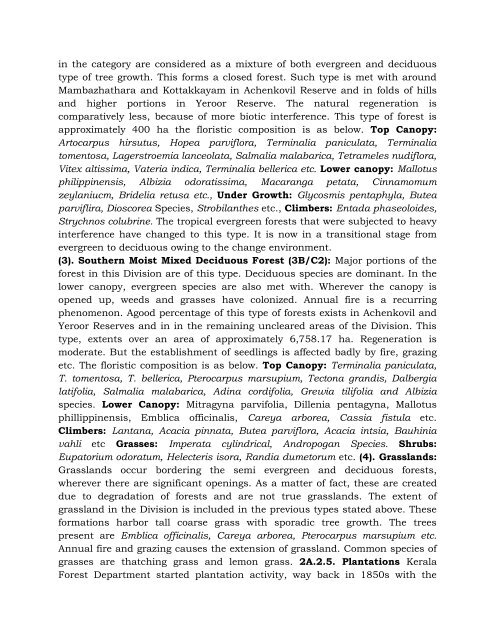
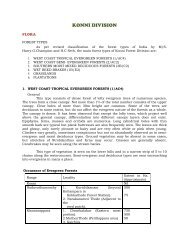
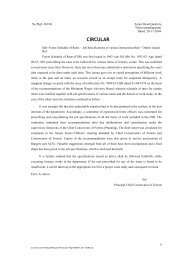
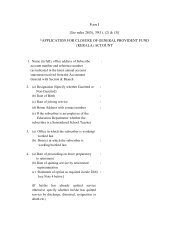
![[See rules 14 & 37(1)] FORM OF APPLICATION FOR TEMPORARY ...](https://img.yumpu.com/49611345/1/190x245/see-rules-14-371-form-of-application-for-temporary-.jpg?quality=85)
